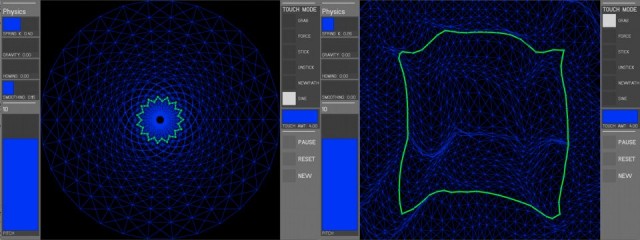It’s a good sign when you need to invent a new verb to describe using a music tool. And so, get ready for some wabbling.
Feel like there aren’t any new synthesis techniques? Scanned synthesis is a reasonable example. Fundamentally, it involves wavetable synthesis – producing new sounds by playing back recorded wavetable content – but navigates those sounds by “scanning” through pitch and timbre independently at slow speeds. By doing so, it simulates slow vibrations in the real world, and it leans heavily on the way human physical control and hearing work.
The technique was developed by Bill Verplank (the legendary interaction designer – who helped coin the term), Rob Shaw, and synthesis giant Max Mathews (who invented – uh, the whole digital synthesis thing). It’s a marvel both of sound design and interaction, accordingly.
English developer Robert Tubb has reinterpreted scanned synthesis in a beautiful implementation for iPad, with fingers running across geometric meshes that make the relationship of input to sound clearer. The resulting app: The Wablet. Rob writes CDM:
It’s the first implementation of Scanned Synthesis on a multi-touch screen. A 2D mesh of springs can be, uh, “wabbled” with the fingers, a path is scanned at audio frequencies and hence gestures are turned into sound. It won a prize at the DAFx conference this year.
It sounds amazing, and the interaction of graphics, touch, and sound is extraordinary – so, you’ll need to watch the video.
http://www.rootnot.co.uk/wablet/
Wikipedia has a great capsule description of scanned synthesis with resources, including various implementations (like a free set of externals for Pd and VST plug-ins, in case you don’t only want to use an iPad):
http://en.wikipedia.org/wiki/Scanned_synthesis
Full description:
The Wablet is a physics based synthesiser and noise toy. An animated mesh of springs can be vibrated with the fingers. A path around this mesh is read as into an audio waveform, and hence your gestures are turned into sound. Complex evolving drones, chiptunes bleeps or full on noise can be produced, and beautiful undulating patterns created. The physical properties of the mesh can be changed using the sliders, new sound-paths can be drawn onto the Mesh and the App comes with a Max/MSP patch for wireless MIDI control and more in depth adjustable parameters.
There’s also a full thesis on the technique, and a Max for Live patch to assist in wireless MIDI control.
Price: £0.69 on the iTunes App Store
Now, the bad news: if you’re in the US, you can’t get the app, as there’s a patent on the technique there. (Can anyone advise on that, in fact?)
